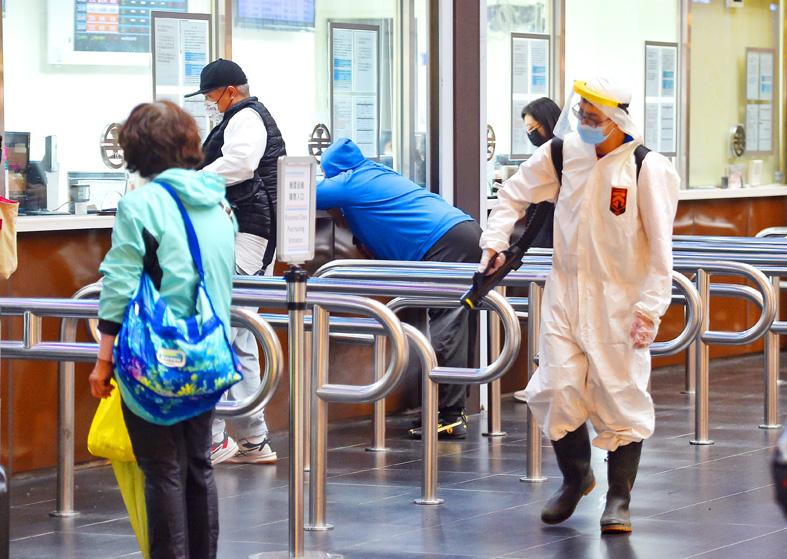More than 99 percent of local COVID-19 cases so far this year reported having mild or no symptoms, the Central Epidemic Command Center (CECC) said yesterday, as it announced modified quarantine and isolation standards, and plans to expand healthcare capacity to meet rising caseloads.
Minister of Health and Welfare Chen Shih-chung (陳時中), who heads the center, said that 1,370 local COVID-19 infections were reported between Jan. 1 and Friday, and 1,367 people, or 99.78 percent, were asymptomatic or had only mild symptoms.
Only three cases, or 0.22 percent, experienced medium to severe illness from COVID-19, and they were all aged 60 or older, including a woman in her 80s who died, Chen said.

Photo: Liu Hsin-de, Taipei Times
Although the percentage is relatively low, people should still be cautious and get vaccinated, he said.
The nation’s first, second and booster vaccination rates on Friday were 83.45 percent, 78.41 percent and 50.48 percent respectively, while 70.98 percent of people eligible for a booster shot have received one, he said.
Under a new CECC standard, people who are asymptomatic or have mild symptoms would be sent to isolate in enhanced centralized quarantine facilities or disease prevention hotels, while people aged 65 or older and those with medium or severe symptoms would be sent to hospitals, Chen said.
“We have not come to the point where we are asking people with mild symptoms to self-isolate at home, but instead will arrange for them to isolate at other facilities, so case classification is important,” Chen said.
Cases detected among people arriving in Taiwan would be transported to enhanced centralized quarantine facilities in central or southern Taiwan, he said, adding that local cases would be sent to nearby facilities.
Two people who are asymptomatic or have mild symptoms and are family members, coresidents or fellow travelers, can stay in the same room at a hospital, quarantine facility or disease prevention hotel, he said.
Regarding healthcare capacity, Chen said that certain designated hospitals with more than 500 beds in Keelung, New Taipei City, Taipei and Taoyuan have been asked to reserve 5 percent of their total bed capacity in three days to be used as COVID-19 hospital rooms, he said.
Regional response hospitals in the four cities have also been asked to clear out 20 percent of their total hospital beds in three days for use as COVID-19 hospital rooms, he said, adding that 90 percent of the rooms in centralized quarantine facilities would be used for admitting COVID-19 cases.
Chen said the center would also discuss with local governments encouraging hotels to provide more enhanced disease prevention rooms — at least 50 — with a goal of two rooms per 10,000 people in each city or county.

LONG FLIGHT: The jets would be flown by US pilots, with Taiwanese copilots in the two-seat F-16D variant to help familiarize them with the aircraft, the source said The US is expected to fly 10 Lockheed Martin F-16C/D Block 70/72 jets to Taiwan over the coming months to fulfill a long-awaited order of 66 aircraft, a defense official said yesterday. Word that the first batch of the jets would be delivered soon was welcome news to Taiwan, which has become concerned about delays in the delivery of US arms amid rising military tensions with China. Speaking on condition of anonymity, the official said the initial tranche of the nation’s F-16s are rolling off assembly lines in the US and would be flown under their own power to Taiwan by way

OBJECTS AT SEA: Satellites with synthetic-aperture radar could aid in the detection of small Chinese boats attempting to illegally enter Taiwan, the space agency head said Taiwan aims to send the nation’s first low Earth orbit (LEO) satellite into space in 2027, while the first Formosat-8 and Formosat-9 spacecraft are to be launched in October and 2028 respectively, the National Science and Technology Council said yesterday. The council laid out its space development plan in a report reviewed by members of the legislature’s Education and Culture Committee. Six LEO satellites would be produced in the initial phase, with the first one, the B5G-1A, scheduled to be launched in 2027, the council said in the report. Regarding the second satellite, the B5G-1B, the government plans to work with private contractors

‘NARWHAL’: The indigenous submarine completed its harbor acceptance test recently and is now under heavy guard as it undergoes tests in open waters, a source said The Hai Kun (海鯤), the nation’s first indigenous defense submarine, yesterday began sea trials, sailing out of the Port of Kaohsiung, a military source said. Also known as the “Narwhal,” the vessel departed from CSBC Corp, Taiwan’s (台灣國際造船) shipyard at about 8am, where it had been docked. More than 10 technicians and military personnel were on deck, with several others standing atop the sail. After recently completing its harbor acceptance test, the vessel has started a series of sea-based trials, including tests of its propulsion and navigational systems, while partially surfaced, the source said. The Hai Kun underwent tests in the port from

MISSION: The Indo-Pacific region is ‘the priority theater,’ where the task of deterrence extends across the entire region, including Taiwan, the US Pacific Fleet commander said The US Navy’s “mission of deterrence” in the Indo-Pacific theater applies to Taiwan, Pacific Fleet Commander Admiral Stephen Koehler told the South China Sea Conference on Tuesday. The conference, organized by the Center for Strategic and International Studies (CSIS), is an international platform for senior officials and experts from countries with security interests in the region. “The Pacific Fleet’s mission is to deter aggression across the Western Pacific, together with our allies and partners, and to prevail in combat if necessary, Koehler said in the event’s keynote speech. “That mission of deterrence applies regionwide — including the South China Sea and Taiwan,” he